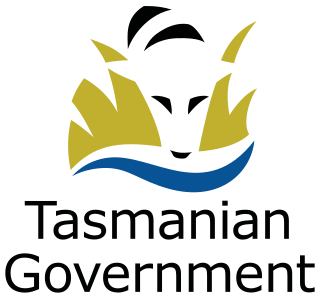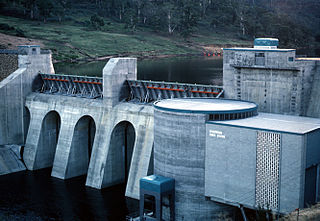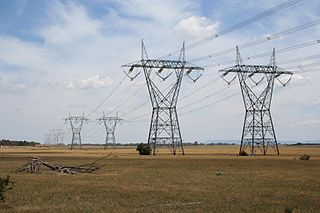
Hydro Tasmania, known for most of its history as the Hydro-Electric Commission (HEC) or The Hydro, is the trading name of the Hydro-Electric Corporation, a Tasmanian Government business enterprise which is the predominant electricity generator in the state of Tasmania, Australia. The Hydro was originally oriented towards hydro-electricity, due to Tasmania's dramatic topography and relatively high rainfall in the central and western parts of the state. Today Hydro Tasmania operates thirty hydro-electric and one gas power station, and is a joint owner in three wind farms.

Transend Networks Pty Ltd was a Tasmanian government-owned business which operated between 1998 and 2014 as the electricity transmission network provider for Tasmania, Australia. It was formed by the disaggregation of the Hydro-Electric Commission, and ceased operation when it was merged on 1 July 2014 with the distribution division of Aurora Energy to form the combined network business TasNetworks.

Aurora Energy is a Tasmanian Government-owned electricity retailer in Tasmania, Australia.

The Tasmanian Government or the Government of Tasmania is the executive branch of the Australian state of Tasmania. The leader of the party or coalition with the confidence of the House of Assembly, the lower house of the Parliament of Tasmania, is invited by the governor of Tasmania to form the executive. The governor appoints the premier of Tasmania.
The National Electricity Market (NEM) is an arrangement in Australia's electricity sector for the connection of the electricity transmission grids of the eastern and southern Australia states and territories to create a cross-state wholesale electricity market. The Australian Energy Market Commission develops and maintains the Australian National Electricity Rules (NER), which have the force of law in the states and territories participating in NEM. The Rules are enforced by the Australian Energy Regulator. The day-to-day management of NEM is performed by the Australian Energy Market Operator.

Ergon Energy Network is a subsidiary company of Energy Queensland Limited (EQL) a Government owned corporation owned by the Government of Queensland. It distributes electricity to around 763,000 customers across Queensland, excluding South East Queensland through a distribution network regulated by the Australian Energy Regulator (AER) who set the prices that Ergon is allowed to charge for distribution.

Integral Energy was the second largest state-owned energy corporation in New South Wales, incorporated under the Energy Services Corporations Act 1995 from a merger between Prospect Electricity and Illawarra Electricity. Integral Energy was involved in electricity retail in addition to owning an electricity distribution network and previously held licences to retail electricity in the contestable markets covered by the NEM.

Rail transport in Tasmania consists of a network of narrow gauge track of 1,067 mm reaching virtually all cities and major towns in the island state of Tasmania, Australia. Today, rail services are focused primarily on bulk freight, with no commercial passenger services being operated. The mainline railways of Tasmania are currently operated by TasRail, a Government of Tasmania-owned Corporation, who owns and maintains both rolling stock, locomotives, and track infrastructure.

The Meadowbank Power Station is a run-of-the-river hydroelectric power station located in the Central Highlands region of Tasmania, Australia. The power station is situated on the Lower River Derwent catchment and is owned and operated by Hydro Tasmania.

SA Power Networks is the principle electricity distributor in the state of South Australia, delivering electricity from high voltage transmission network connection points operated by ElectraNet. It is the successor to the Electricity Trust of South Australia.

Energy in Victoria, Australia is generated using a number of fuels or technologies, including coal, natural gas and renewable energy sources. Brown coal, historically, was the main primary energy source for the generation of electricity in the state, accounting for about 85% of electricity generation in 2008. The amount of coal-fired power has decreased significantly with the closure in 2017 of the Hazelwood power station which supplied around 20% of Victoria's electricity, and to a lesser extent with the exit of Anglesea power station in 2015. Brown coal is one of the largest contributors to Australia's total domestic greenhouse gas emissions and a source of controversy for the country. Australia is one of the highest polluters of greenhouse gas per capita in the world.
The Office of the Tasmanian Economic Regulator, or OTTER is the Tasmanian Government agency responsible for various economic and energy supply regulating actions in the Australian state of Tasmania. OTTER is a member of the national Utility Regulators Forum, and it has its headquarters in Hobart, Tasmania.

AusNet Services is an Australian energy delivery services business, owning and operating more than $11 billion of electricity and gas network assets. It is a privately held, and was formerly listed on the Australian Securities Exchange (ASX) and the Singapore Exchange (SGX). AusNet is currently owned by Australian Energy Holdings No 4 Pty Limited, a company controlled by Brookfield Asset Management. The co-investors include pension funds in Australia and Canada.
Tamar Valley Power Station is a $230 million natural gas-fired power station located in Bell Bay in the Tamar Valley, Tasmania. It is owned by Hydro Tasmania, and is immediately adjacent to the decommissioned Bell Bay Power Station, which is also owned by Hydro Tasmania.
The Australian Energy Market Operator (AEMO) performs an array of gas and electricity market, operational, development and planning functions. It manages the National Electricity Market (NEM), the Wholesale Electricity Market (WA) (WEM) and the Victorian gas transmission network. AEMO also facilitates electricity and gas full retail contestability, overseeing these retail markets in eastern and southern Australia. It is additionally responsible for national transmission planning for electricity and the establishment of a Short Term Trading Market (STTM) for gas.
The Basslink electricity interconnector is a 370 km (230 mi) 500 MW (670,000 hp) high-voltage direct current (HVDC) cable linking the electricity grids of the states of Victoria and Tasmania in Australia, crossing Bass Strait, connecting the Loy Yang Power Station, Victoria on the Australian mainland to the George Town substation in northern Tasmania. Basslink is bidirectional and enables Hydro Tasmania to supply some of the peak load capacity to the Australian mainland and take some of the excess power from the mainland when the generation on the mainland exceeds the demand.

Powerlink Queensland is an electricity transmission system operator owned by the Government of Queensland which operates the high-voltage electricity transmission infrastructure in Queensland.

The electricity sector in Australia has been historically dominated by coal-fired power stations, but renewables are forming a rapidly growing fraction of supply. In 2021, Australia's electricity production reached 265 TWh, with coal accounting for 52.9% and natural gas for 18.8%. Renewable sources, comprising solar, wind, hydro, and bioenergy with waste, collectively made up 26.7% of the total electricity generation mix.
Marinus Link is a proposed 750 megawatt capacity high voltage direct current (HVDC) electricity interconnector, to strengthen the connection between the Australian states of Tasmania and Victoria, on Australia's National Electricity Market. Due to inflation, Marinus link was scaled back from an initial plan of 1500 MW via two cables, down to 750 MW via one cable. It involves approximately 250 km of subsea cables and approximately 90 km of underground land cables. Marinus Link will also incorporate significant optical fibre capacity for system control, with the remaining capacity available to strengthen telecommunications and data connectivity between the regions. Marinus Link will be supported by approximately 220 km of high voltage alternating current (HVAC) of proposed transmission developments in North West Tasmania, known as the North West Transmission Developments (NWTD). Collectively, Marinus Link and the North West Transmission Developments are known as Project Marinus. In October 2022, authorities pledged loans for the project, as well as supporting facilities such as pumped hydro in Tasmania.
Tasmania, as an advanced economy with a globally high standard of living, uses a great deal of energy. Distinctive features of energy use in Tasmania include the high fraction of hydroelectricity usage, the absence of coal-fired electrical generation, relatively light usage of natural gas, particularly for domestic use, and a wide use of domestic wood-burning stoves. Energy production through hydroelectricity has been politically contentious, and conflicts over Tasmanian hydroelectric projects were integral to the formation of Green parties in Australia and across the world.













